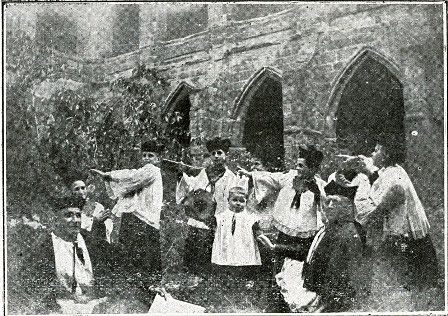The piece of the month of November 2009
A PHOTOGRAPH OF THE CHOIR OF INFANTES DE FITERO IN 1904
Ricardo Fernández Gracia
Chair of Navarrese Heritage and Art
Among the realities that have gone down in history in some of our localities are the stable children's choirs in important temples, in clear imitation of the choirs of infants in cathedrals, collegiate churches and distinguished churches. The photograph we present here shows the choir of infants in the parish of Fitero, in 1904, in a snapshot probably taken by the photographer Mauro Azcona, who lived in the town between 1903 and 1908 and was the father of Mauro (Torrelavega, 1903 - Moscow, 1982) and Victor (Fitero, 1905 - Bilbao, 1994), both pioneers of Basque cinema.
The history of music in the abbey of Fitero is particularly difficult to reconstruct due to the lack of materials subject, although there is no lack of such outstanding pieces as the Cistercian Sacramentary, beautifully illustrated and dating from the years when the abbey church was inaugurated. We have more information from the 19th century, when the old abbey church was converted into the town's parish church. Thus, we know that in the Parish Arrangement of 1856, a kind of regulation for the internal use of the chapter and staff assigned to the service of the parish, it is about the characteristics of the choir of infants that was under the care of the organist, being his obligation to educate the children in the theory and the musical internship , so that they could solemnize with their careful voices so many religious functions. We do not know if this small musical ensemble had any antecedents in the obacial period. Its stable character was the work of the exclaustrated friar Joaquín Aliaga, parish priest between 1853 and 1898. Joaquín, of Carlist convictions, always tried to restore the solemnity of worship and the liturgy of the Cistercian period. He did so with some now extinct confraternities and with different customs that have survived to the present day, even in the attempt to keep the parish as a nullius diocesis, a matter that was finally settled in favor of the Bishop of Tarazona in 1859, by decision of Rome.
position The Education de los Infantes was the work of the organists of the second half of the 19th century and the beginning of the following century: Don Blas Ibáñez, Manuel María Hernández, José Spanish, Severiano Pastor, Manuel María Muro and his son Ángel Muro. In the agreements that the organists signed with the parish priests, one of the clauses included the obligation to teach music to the children or infants determined by the parish priest, after voice tests. The work was arduous and burdensome for the organists and the sacristan who helped him with the children. The intervention of the infants is documented in the accounts of different local brotherhoods throughout the year, in as many functions, novenas, triduums and feasts.

Infants in the cloister of the monastery of Fitero with the organist and the sacristan, c. 1904.
The photograph that we present, dated 1904, is a faithful exponent of that reality that would disappear soon after, around 1912, approximately one hundred years ago. It shows the infantes with the sacristan and the organist. The first of them, Cristóbal Magaña (deceased in 1918), on the left, wears choir robes, cassock, roquete, moustache and hood and, besides being a kind of master of ceremonies of the chapter, accompanied in certain liturgical periods with the euphonium some masses, rosaries and other liturgical functions. On the right, with similar habits, we find the organist Ángel Muro Cazcarro, son of another organist of the locality called Manuel María Muro Jiménez de Azcárate, both natives of Corella. Ángel, born in Corella in 1867, married Dámasa Asensio in Fitero in 1886 at the age of eighteen and left the town in 1904 to live in San Sebastián, after directing the music band and occupying the parish organist's office for some years. The custom of dressing the organist lasted until 1912, when a young man from Tierra Estella, Amado Urmeneta, repeatedly refused to do so. Between the sacristan and the organist, in the center of the photograph is a young boy, possibly one of the organist's young children. Standing from left to right we have been able to identify Saturnino Larrea, Javier Olóndriz, born in 1892, Luis Palacios Martínez with the baton, born in 1894, Javier Olóndriz, born in 1892, another two unidentified, Serafín Escudero, another one whose face is unknown and Pedro Moreno, also born in 1892. All of them dress like the altar boys of the parish, wearing a cassock, a roquette with an elegant triangular chorrera and a four-pointed hood with a tassel.
The date when the photograph was taken -1904-, during the period of stay in Fitero of the "itinerant" photographer Mauro Azcona, of whom we have prepared a small study of his time in the village of La Ribera, together with other snapshots of ceremonies, offices and popular types by the aforementioned Azcona, has led us to attribute this photo of the infants in the cloister of the abbey to this photographer born in Vitoria in 1879 and who married Encarnación Pérez Manero from La Rioja. This supposition is supported by the fact that in Fitero there was no photographer or machine in the hands of private individuals until a few years later when the merchant José Luis Armas and the doctor Benjamín Retuerta had them. Finally, another reason that leads us to Mauro Azcona is that this photographer was able to work outdoors, as he did in the already published photograph of a house in Cornago, something not very common at that time [Vid. IRULEGUI BLASCO, B., "Una fotografía, una casa, una familia", Belezos. Revista de cultura popular y tradiciones de la Rioja, no. 2 (2003), p. 14].
